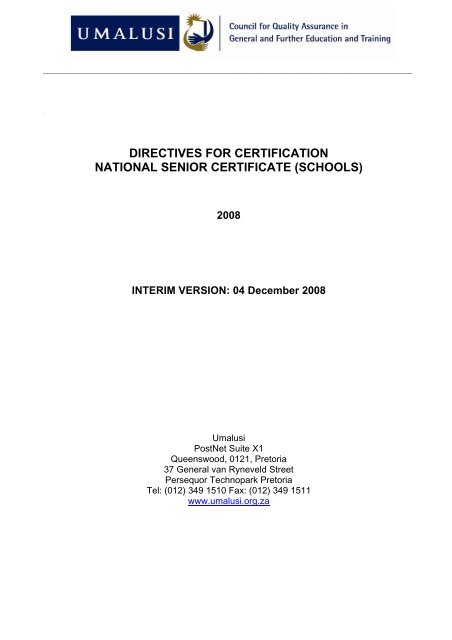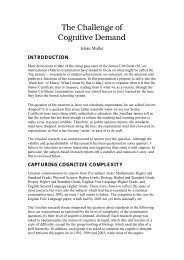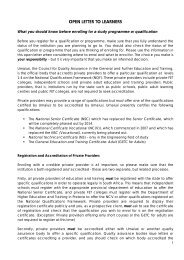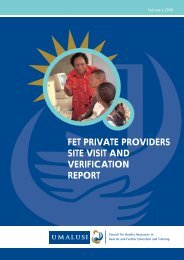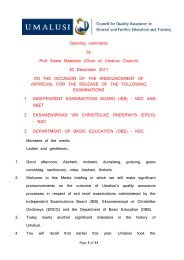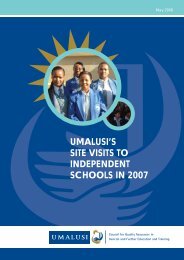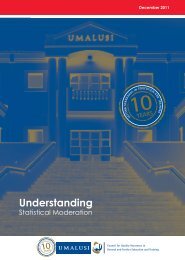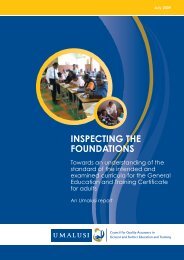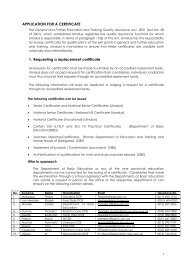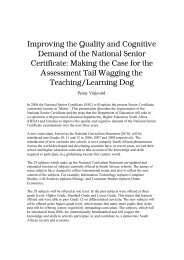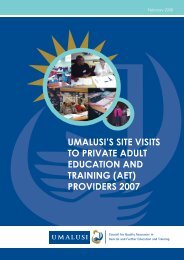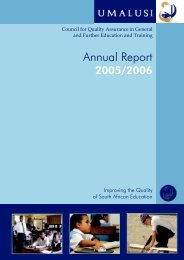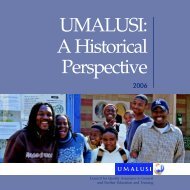directives for certification national senior certificate - Umalusi
directives for certification national senior certificate - Umalusi
directives for certification national senior certificate - Umalusi
Create successful ePaper yourself
Turn your PDF publications into a flip-book with our unique Google optimized e-Paper software.
DIRECTIVES FOR CERTIFICATION NATIONAL SENIOR CERTIFICATE (SCHOOLS)AcronymsABETDoEFETGETHESALOLTNSCNQFGETCPATSBAAdult Basic Education and TrainingDepartment of EducationFurther Education and TrainingGeneral Education and TrainingHigher Education South AfricaLanguage of Learning and TeachingNational Senior Certificate (schools)National Qualifications FrameworkGeneral Education and Training CertificatePractical Assessment TaskSchool Based AssessmentGuidelines and Directives <strong>for</strong> <strong>certification</strong> NSC5 of 43
DIRECTIVES FOR CERTIFICATION NATIONAL SENIOR CERTIFICATE (SCHOOLS)Glossaryassessment body<strong>certification</strong>a department of education or any other body accredited by<strong>Umalusi</strong> to be responsible <strong>for</strong> conducting external assessment<strong>for</strong> all or some subjects of the NSC.<strong>certification</strong> is the <strong>for</strong>mal recognition of a full qualification orsubject/unit offered by a candidate.external examinationfull-time candidateimmigrant candidatelearnerlevel of competenceNational SeniorCertificatean external component of the assessment process; refers tothe culmination of the summative assessment process whenstudents are subjected to a final <strong>for</strong>mal assessment in anexamination sitting.a candidate who has enrolled <strong>for</strong> tuition and who offers aNational Senior Certificate programme in a full-time capacitywith 7 subjects. Such a candidate must fulfil all internalassessment requirements, including oral and practicalrequirements where applicable.a candidate who enters the South African school system at alate stage and, as a result, has not been exposed to the fullspectrum of all the South African official languages. Such acandidate will under certain conditions be exempted fromcomplying with the language requirements of the NSC.refers to any person, including part-time learner, receivingtuition at a public or independent school or at a learninginstitution under an accredited assessment body.the level awarded to a specific subject against agreed uponcriteria to indicate the level of achievement.a <strong>certificate</strong> awarded as a final exit qualification to candidatewho have complied with the exit level outcomes stipulated inthe National Curriculum Statement (Grades 10 – 12) <strong>for</strong> theNational Senior Certificate, a qualification at Level 4 on theNQF .National QualificationFramework (NQF)part-time candidateis a ten level framework to provide <strong>for</strong> the registration of<strong>national</strong> standards and qualifications.a candidate who does not receive full-time tuition and registers<strong>for</strong> any number of subjects in one examination sitting. Such acandidate must fulfil all internal and external assessmentGuidelines and Directives <strong>for</strong> <strong>certification</strong> NSC6 of 43
DIRECTIVES FOR CERTIFICATION NATIONAL SENIOR CERTIFICATE (SCHOOLS)requirements, including oral and practical requirements whereapplicableweightingrepeat candidatewithdrawn candidateendorsed <strong>certificate</strong>the weight that a specific area within a subject carriestoward the final marksa candidate who has failed the National Senior Certificateexamination and who wants to repeat his or her Grade12–year as a full-time candidatea candidates who enrolled <strong>for</strong> examination and did not writeany subject.a <strong>certificate</strong> issued to a candidate identified as having specialneeds which has its own promotion requirements.Guidelines and Directives <strong>for</strong> <strong>certification</strong> NSC7 of 43
DIRECTIVES FOR CERTIFICATION NATIONAL SENIOR CERTIFICATE (SCHOOLS)Executive summaryThe purpose of this document is to provide in<strong>for</strong>mation to assessment bodies who submitcandidates’ achievement records <strong>for</strong> NSC <strong>certification</strong> to <strong>Umalusi</strong>. This document isspecific to the <strong>certification</strong> of the National Senior Certificate.This document:• provides guidelines that clarify the way in which candidates are resulted after anexamination;• Outlines the specific <strong>directives</strong> regarding the submission of candidate in<strong>for</strong>mation<strong>for</strong> <strong>certification</strong>, the way in which <strong>Umalusi</strong> certifies, and clarifies the <strong>for</strong>mat in whichin<strong>for</strong>mation is to be submitted <strong>for</strong> <strong>certification</strong>.• Provides clarity on areas within the policy which governs the NSC; and• Gives general in<strong>for</strong>mation on the verification service that <strong>Umalusi</strong> supplies.Guidelines and Directives <strong>for</strong> <strong>certification</strong> NSC8 of 43
DIRECTIVES FOR CERTIFICATION NATIONAL SENIOR CERTIFICATE (SCHOOLS)1 Directives <strong>for</strong> Certification1.1 IntroductionThe General and Further Education and Training Quality Assurance Act, 2001 (ActNo. 58 of 2001), which established <strong>Umalusi</strong>, legislates the quality assurancefunctions <strong>for</strong> which <strong>Umalusi</strong> is responsible. In terms of paragraph 16(2)(e) of thisAct, <strong>Umalusi</strong> has the responsibility <strong>for</strong> issuing <strong>certificate</strong>s <strong>for</strong> qualifications at theexit points in the general and further education and training bands. <strong>Umalusi</strong> ismandated to ensure that these <strong>certificate</strong>s are credible both <strong>national</strong>ly andinter<strong>national</strong>ly.<strong>Umalusi</strong>, there<strong>for</strong>e issues <strong>certificate</strong>s to candidates as stipulated in the regulations<strong>for</strong> the issuing of <strong>certificate</strong>s. The <strong>directives</strong> <strong>for</strong> <strong>certification</strong> will help assessmentbodies to submit the candidates’ assessment records <strong>for</strong> <strong>certification</strong>. Thisdocument should be read together with the policies as approved by the Minister:• Government Gazette, Vol. 481, 1\10. 27819, July 2005. National Senior Certificate– A qualification at level 4 on the National Qualifications Framework• Government Gazette, Vol. 482, No. 27961, August 2005, Minimum AdmissionRequirements <strong>for</strong> Higher Certificate/ Diploma and Bachelor's Degree Programmesrequiring a National Senior Certificate, as amended in July 2008.• Government Gazette vol. 751 No. 31231 of 11 July 2008, Admission Requirements<strong>for</strong> Higher Certificate, Diploma and Bachelor's Degree Programmes• Government Gazette vol. 498 No. 29466 of 11 December 2006, Rules andRegulations An addendum to the policy document, the National Senior Certificate –A qualification at level 4 on the National Qualifications Framework regardinglearners with special needs.• Government Gazette vol. 498 No. 29467 of 11 December 2006, Addendum to thePolicy Document, The National Senior Certificate a qualification at Level 4 on theNational Qualifications Framework (NQF), regarding learners with special needs.• Government Gazette vol 502 No 29851 of 30 April 2007 National Policy regardingFurther Education and Training Programme: Approval of the amendments to theprogramme and Promotion Requirements <strong>for</strong> the National Senior Certificate asstipulated in the Policy Document ,The National Senior Certificate: A qualification atLevel 4 on the National Qualifications Framework.• Government Gazette vol 508 No 30371 of October 2007 National Policy regardingFurther Education and Training Programme: Approval of the amendments to theprogramme and Promotion Requirements of the Endorsed National SeniorCertificate.• Government Gazette vol. 505 No. 30048 of 6 July 2007, National Policy on theconduct, Admin & Management of NSC.• Government Gazette vol. 928 No. 30353 of 5 October 2007, Higher EducationQuality Framework.• Government Gazette, Vol. 960, No. 30371, October 2007, Addendum to the policydocument, the National Senior Certificate – A qualification at level 4 on the NationalQualifications Framework regarding learners with special needs.Guidelines and Directives <strong>for</strong> <strong>certification</strong> NSC9 of 43
DIRECTIVES FOR CERTIFICATION NATIONAL SENIOR CERTIFICATE (SCHOOLS)• Government Gazette vol. 961 No. 30371 of 11 October 2007, Amendments toPromotion Requirements NSC.• Government Gazette vol. 512 No. 30778 of 15 Feb 2008, National QualificationsFramework Bill, 2008: Higher Education Act.• Quality Assurance of Assessment; Policies, Directives, Guidelines andRequirements; July 2006• Department of Education ministerial approved policy changes Circulars S3, S4, S5,S6, S7, S8, S9, S10, S12, S13 of 2006• Government Gazette No. 1754 of 2 December 2003 (Government Gazette No.25794 of 2 December 2003), as amended in Government Notice No. 158 of 2005(Government Gazette No. 27249 of 4 February 2005), published by the Minister ofEducation, amended in Government Gazette Notice No. 507 of September 2007(Government Gazette No. 30283 of 10 September 2007), and (to be added onceregulation is published <strong>for</strong> NSC)• Department of Education, The Combination of the National Senior Certificate (NSC)and the German Abitur Examination, 4 April 20006.In order to issue <strong>certificate</strong>s, <strong>Umalusi</strong> maintains the capacity to:• develop and maintain policies and <strong>directives</strong> <strong>for</strong> <strong>certification</strong>;• maintain acceptable standards <strong>for</strong> awarding <strong>certificate</strong>s;• maintain a <strong>certification</strong> system and infrastructure including appropriate securityarrangements;• verify <strong>certificate</strong>s; and• issue replacement <strong>certificate</strong>s.<strong>Umalusi</strong> has the responsibility <strong>for</strong> issuing the following <strong>certificate</strong>s in the GET andFET bands (NQF Levels 1 to 4):• Senior Certificate (Report 550);• National Senior Certificate (Schools);• National Senior Certificate (Report 190 and 191) ;• National N3 Certificate (Report 190 and 191);• National Certificate (Vocational) (NC(V));• Subject Certificate (Report 550 and Report 190 and 191);• Subject Certificate (National Certificate (Vocational));• General Education and Training Certificate (GETC);• Learning Area Certificate (GETC);• Unit Standard Certificate (GETC); and• Subject Statement (NC(V) and NSC).<strong>Umalusi</strong> issues <strong>certificate</strong>s <strong>for</strong> candidates when requested to do so by anaccredited assessment body.1.2 The Purpose of the <strong>directives</strong>.The purpose of these <strong>directives</strong> arises from the need to provide a commonunderstanding of the responsibilities and requirements spelled out in the policy onGuidelines and Directives <strong>for</strong> <strong>certification</strong> NSC10 of 43
DIRECTIVES FOR CERTIFICATION NATIONAL SENIOR CERTIFICATE (SCHOOLS)the National Senior Certificate at Level 4 of the NQF, The National SeniorCertificate a Qualification at Level 4 on the National Qualifications Framework(NQF). Furthermore, these guidelines will assist assessment bodies to request<strong>certification</strong> <strong>for</strong> candidates who have offered the National Senior Certificate.This document will also assist assessment bodies to determine a candidate’sresults in terms of the requirements stipulated in the policy, and will give directionon how to structure the in<strong>for</strong>mation required <strong>for</strong> submission to <strong>Umalusi</strong> <strong>for</strong> theissuing of candidates’ <strong>certificate</strong>s.<strong>Umalusi</strong> has published <strong>directives</strong> <strong>for</strong> <strong>certification</strong> with respect to qualifications it hascertified since September 1992. These <strong>directives</strong> remain applicable and will berevised once all new qualifications certified by the Council, have been implemented.1.3 Changes to qualifications in the FET band.The Senior Certificate (Report 550) <strong>for</strong> full-time candidates will be written <strong>for</strong> the lasttime in 2007 and will be replaced by the National Senior Certificate in 2008, when itwill be assessed as an exit level qualification <strong>for</strong> the first time in 2008. Part-timecandidates who obtained Senior Certificate credits be<strong>for</strong>e 2008 (Report 550) will beallowed to complete the outstanding requirements <strong>for</strong> awarding this qualificationuntil 2011. No full-time candidates will be allowed to offer the Senior Certificatequalification after May/June 2008.The National N3 (Report 190 and 191) and National Senior Certificate (Report 190and 191) offered in FET colleges will be phased out in 2009 and will be replaced bythe National Certificate (Vocational), Levels 2, 3 and 4. The new National SeniorCertificate (Schools) does not replace the National Senior Certificate and N3 (Nated190 and191) qualifications.1.4 Compliance by an assessment body.<strong>Umalusi</strong> awards qualifications based on the credibility of the assessment byaccredited assessment bodies. In order to satisfy itself of the integrity of theassessment opportunity offered, <strong>Umalusi</strong> may require an assessment body seekingaccreditation to:• submit full details of its assessment system and practices from time to time; and• Notify <strong>Umalusi</strong> of any amendments to its assessment system.An assessment body shall:• determine the result of a candidate in accordance with the National policy on theNational Senior Certificate: A Qualification at Level 4 on the NationalQualifications Framework and <strong>directives</strong> issued by <strong>Umalusi</strong>;• supply final marks to <strong>Umalusi</strong> in the <strong>for</strong>mat outlined in pages 25 to 34 of the<strong>directives</strong> in terms of regulation 10(g) of the regulations <strong>for</strong> the issuing of<strong>certificate</strong>s as promulgated by the Minister, andGuidelines and Directives <strong>for</strong> <strong>certification</strong> NSC11 of 43
DIRECTIVES FOR CERTIFICATION NATIONAL SENIOR CERTIFICATE (SCHOOLS)• supply <strong>Umalusi</strong> with raw mark adjustments in an <strong>Umalusi</strong> - approved <strong>for</strong>matoutlined in paragraph 18 and 19 of these <strong>directives</strong>.Further in<strong>for</strong>mation on accreditation criteria and required compliance byassessment bodies can be obtained from <strong>Umalusi</strong>’s website (www@umalusi.org.za)or alternatively as hard copies from <strong>Umalusi</strong>’s office. Requests should beaddressed to: The Senior Manager, Evaluation and Accreditation.1.5 Certification.Certification is the <strong>for</strong>mal recognition of a full qualification or subject/unit of learningachieved by a candidate. <strong>Umalusi</strong> will issue a qualification or a subject statement tocandidates who have been assessed by an accredited assessment body againstthe requirements of an approved qualification and curricular.1.6 Certification fees.<strong>Umalusi</strong> determines <strong>certification</strong> fees and will in<strong>for</strong>m assessment bodies well aheadof time about the <strong>certification</strong> fees to be paid in respect of the issuing of <strong>certificate</strong>s<strong>for</strong> a specific financial year.<strong>Umalusi</strong> will issue the National Senior Certificate where a candidate has met theminimum requirements <strong>for</strong> awarding the qualification and a subject statement if thecandidate does not meet the minimum requirements <strong>for</strong> the qualification or meetsthe requirements <strong>for</strong> one or more subjects.2 The National Senior Certificate, a qualification at level 4 on the Nationalqualification framework2.1 PurposeIn terms of the policy <strong>for</strong> the National Senior Certificate (NSC) at Level 4 of theNational Qualifications Framework (NQF), the purpose of the National SeniorCertificate is to:(a)(b)(c)(d)(e)(f)(g)represent a planned combination of Learning Outcomes that has a definedpurpose or purposes, and is intended to provide qualifying candidates withapplied competence and a basis <strong>for</strong> further learning;enrich the qualifying candidateprovide benefits to society and the economy;comply with the objectives of the NQF;where applicable, be inter<strong>national</strong>ly comparable;incorporate integrated assessment; andindicate the rules governing the award of the qualificationGuidelines and Directives <strong>for</strong> <strong>certification</strong> NSC12 of 43
DIRECTIVES FOR CERTIFICATION NATIONAL SENIOR CERTIFICATE (SCHOOLS)2.2 Entrance requirementsThe minimum entrance requirement <strong>for</strong> Grade 10 is an official Grade 9 schoolreport which indicates promotion to Grade 10, or a General Education and TrainingCertificate (GETC) <strong>for</strong> Adult Basic Education and Training (ABET), or a NQF Level1 Certificate, or a recognised equivalent qualification obtained at NQF Level 1.2.3 Duration of the qualification:The minimum duration of the NSC Grades 10-12 (General) programme is threeyears, namely Grades 10, 11 and 12.To obtain a NSC the candidate must:(a) Complete the programme requirements <strong>for</strong> Grades 10, 11 and 12 separatelyand obtain the distinct outcomes and associated assessment standards of allthree years; and(b) Comply with the internal assessment requirements <strong>for</strong> Grades 10, 11 and 12and the external assessment requirements of Grade 12 as contemplated in theNational Subject Statements and the National Subject Assessment Guidelines ofthe various subjects approved in groups A and B listed in paragraph 2.4.2.4 The structure of the qualification and minimum promotion requirementsThe NSC is a registered qualification <strong>certificate</strong> at Level 4 on the NationalQualifications Framework. Both full-time and part-time candidates will offer thisqualification. The qualification is structured according to specific categories ofsubjects and rules of combination.To obtain a National Senior Certificate a candidate must:• Achieve 40% in three subjects, one of which is an official language at HomeLanguage Level ,• Achieve 30 % in three subjects; and• Provide full evidence in the school–based assessment component in thesubject failedNo condonation will be applied in this qualification.The National Senior Certificate will be awarded to a candidate who has compliedwith the following requirements as explained below:SubjectOne Home LanguageOne Home or First Additional LanguageMathematics or Mathematical LiteracyLife Orientation3 x subjects selected from Group BGuidelines and Directives <strong>for</strong> <strong>certification</strong> NSC13 of 43
DIRECTIVES FOR CERTIFICATION NATIONAL SENIOR CERTIFICATE (SCHOOLS)<strong>Umalusi</strong> will issue a subject statement where a candidate does not meet theminimum requirements <strong>for</strong> the issuing of a National Senior Certificate.<strong>Umalusi</strong> will NOT issue a subject statement <strong>for</strong> stand-alone subjects from otherassessment bodies and/or <strong>for</strong> Mathematics P3 probability, data handling andgeometrySubjects are grouped into several categories of which group A and group B are themost commonly used:Group A• The official languages at Home and First Additional language Level• Mathematical Sciences• Human and Social StudiesGroup B• Agriculture• Culture and Arts:• Business, Commerce and Management Studies• Official languages at Second Additional Level and non-official languages:• Engineering and Technology• Human and Social Studies:• Physical, Mathematical, Computer and Life Sciences• ServicesGroup C: Subjects from other Assessment Bodies that are approved by theMinister of Education• Agriculture: Equine studies• Culture and Arts:o Associated Board of Royal Schools of Music Practical MusicExamination Grade 4-7o Trinity College of London practical Music Examination Grade 4-7o UNISA Practical Music Examination Grade 4-7• Business, Commerce and Management Studies: Maritime Economics• Non-official Languages: Modern Greek Second Additional Language• Engineering and Technology: Nautical Science• Human and Social Studies: Sports and Exercise Science2.5 Weighting of internal and external assessment:All candidates (both full-time and part-time) must comply with the internalassessment requirements associated with this qualification.Subject in<strong>for</strong>mation required by <strong>Umalusi</strong> <strong>for</strong> determining a candidate’s results mustinclude the internal assessment mark (25%) as part of the final standardized marks.<strong>Umalusi</strong> certifies qualifications on the basis of an internal assessment componentand an external examination, both of which contribute to the candidate’s final result.Guidelines and Directives <strong>for</strong> <strong>certification</strong> NSC14 of 43
DIRECTIVES FOR CERTIFICATION NATIONAL SENIOR CERTIFICATE (SCHOOLS)Internal assessment and external examinations are central to the quality assuranceprocesses and are both mandatory at exit levels.The assessment body must ensure that the <strong>directives</strong> <strong>for</strong> internal assessment asstipulated by <strong>Umalusi</strong> are adhered to.Weighting <strong>for</strong> internal and external assessment is explained below:Subject typeExternalassessmentInternalassessmentHome Language 75% 25%Home/First Additional Language 75% 25%Mathematics/Mathematical 75% 25%LiteracyLife Orientation - 100%3 Subject selected from Group B 75% 25%Weighting <strong>for</strong> internal and external assessment in subjects with a practicalassessment component.Assessment tasksEnd-of-year assessmentSBA (School Based Assessment) Exam Paper=50%PAT=25% [If the subject has aPAT component]25% 75%2.6 Subject combinations <strong>for</strong> awarding a NSCFour subjects from Group A selected as follows:(i)(ii)(iii)(iv)(v)Two (2) official languages selected from Group A, provided that one of the twoofficial languages is offered on the Home Language level, and the other, on eitherHome or First Additional Language level, and provided that one of the twolanguages is the language of learning and teaching (LOLT) at the school/institutionthat the candidate has attended.Mathematics or Mathematical LiteracyLife OrientationA minimum of any three subjects selected from Group B. Of the minimum threerequired subjects, a maximum of two additional languages over and above the twoofficial languages contemplated in paragraph2.6 (i) may be offered.Candidates may offer a maximum of one subject assessed and developed by<strong>Umalusi</strong> accredited assessment bodies other than the Department of Education tomeet the requirements of three subjects as contemplated in paragraph 6 of thisdocument provided that such a subject is accommodated in the National SeniorCertificate: A qualification at Level 4 on the National QualificationsFramework(NQF) and National policy on the conduct, administration andmanagement of the National Senior Certificate: A qualification at Level 4 on theNational Qualifications Framework(NQF).Guidelines and Directives <strong>for</strong> <strong>certification</strong> NSC15 of 43
DIRECTIVES FOR CERTIFICATION NATIONAL SENIOR CERTIFICATE (SCHOOLS)3 Minimum Promotion requirements <strong>for</strong> awarding the National Senior Certificate tocandidates with special needs3.1 Grade 10 – 12 learners who experience barriers to learning will be allowed to followone of two learning pathways with the aim of a qualification. These are:(a) The National Senior Certificate (NSC) as stipulated in the policy document, TheNational Senior Certificate: A qualification at Level 4 on the NationalQualifications Framework (NQF); or(b) An endorsed National Senior Certificate gazetted <strong>for</strong> learners with specialneeds, qualifying <strong>for</strong> the Addendum to the policy document, The National SeniorCertificate: A qualification at Level 4 on the National Qualifications Framework(NQF), Government Gazette No 29466, 11 December 2006. The endorsedNational Senior Certificate is <strong>for</strong> candidates who cannot, despite theconcessions granted in the policy cited in 3.1a above, meet the stipulatedrequirements.3.2 Special needs candidates are defined as learners who experience barriers tolearning. A number of concessions, related to the nature of the barrier to learning,identify permissible variants to the rules of combination allowed <strong>for</strong> the NSC.Barriers to learning identified in the policy include: visual, aural, and hearingimpairment, aphasia, dyslexia and mathematical disorders such as dyscalculia.3.3 Candidates with special needs must register as a learner with a barrier to learning;or, in the necessary instances, as an immigrant with a barrier to learning. Unlesscandidates register in terms of section 4 below, candidates are subject to the samepromotion requirements identified <strong>for</strong> NSC candidates as per the policy in 3.1aabove.3.4. Programme and promotion requirements <strong>for</strong> candidates with special needsqualifying <strong>for</strong> the Addendum to the policy document, The National SeniorCertificate: A qualification at Level 4 on the National Qualifications Framework(NQF), Government Gazette No 29466, 11 December 2006.3.4.1 Learners with special needs may follow the learning pathway identified in paragraph3.1(b) above, leading to the endorsed National Senior Certificate, as gazetted in theAddendum, Government Gazette no 29466, 11 December 2006. The addendumspecifies programme and promotion requirements different from those identified inthe policy <strong>for</strong> the National Senior Certificate, cited in 3.1 above.3.4.2 Candidates wishing to be considered <strong>for</strong> the alternative promotion requirements laidout in the Addendum must register as (i) a learner with a barrier to learning, andmust, in addition, and as (ii) a learner offering the NSC in terms of the Addendum.3.4.3 Candidates registered in terms of paragraphs 3.4.1 and 3.4.2 above must offer andcomplete the internal and external assessment <strong>for</strong> not fewer than 5 subjectsselected as follows from Annexure A in the policy document, The National SeniorGuidelines and Directives <strong>for</strong> <strong>certification</strong> NSC16 of 43
DIRECTIVES FOR CERTIFICATION NATIONAL SENIOR CERTIFICATE (SCHOOLS)Certificate: A qualification at Level 4 on the National Qualifications Framework(NQF):(i)(ii)(iii)one official language from Group A, provided that it is offered at leastFirst Additional Language level, and provided that the language is aLOLT;Mathematics or Mathematical Literacy, also from Group ALife Orientation, from Group A; and(iv) a minimum of two subjects selected from Group B.3.4.4 An endorsed National Senior Certificate shall be issued to a candidate registeredin terms of paragraph 3.4.3 above, provided that he or she complies with thefollowing promotion requirements. The candidate must obtain:(i)(ii)at least 30% in the required official language at either Home languageor First Additional Language level;a minimum of 30% in four other subject3.4.5 Should a candidate registered as a special needs candidate in terms of paragraph3.2 above fail the NSC in terms of the promotion requirements of the policydocument, The National Senior Certificate: A qualification at Level 4 on the NationalQualifications Framework (NQF), he or she may request to have her subjects reevaluatedin terms of the promotion requirements outlined in the Addendum. Such arequest must be made through the assessment body which has registered thecandidate. Should the candidate fulfil the promotion requirements outlined inparagraph 3.4.4 above, a change of status <strong>certificate</strong> will be issued to thecandidate, replacing the subject statement with an endorsed National SeniorCertificate.3.4.6 The endorsed Senior Certificate will bear a descriptor indicating that an endorsedSenior Certificate is issued in terms of the Addendum.3.4.7 Candidates with aural impairment and the deaf may offer just one official languageat First Additional Level, provided that another subject from Group B is offered inlieu of the one official language not offered.3.4.8 Candidates with a mathematical learning disability such as dyscalculia may offer anadditional subject from Group B in lieu of offering Mathematics or Mathematicalliteracy.Guidelines and Directives <strong>for</strong> <strong>certification</strong> NSC17 of 43
DIRECTIVES FOR CERTIFICATION NATIONAL SENIOR CERTIFICATE (SCHOOLS)4 Language requirements <strong>for</strong> immigrant candidatesThe language requirements <strong>for</strong> National Senior Certificate in the case of animmigrant candidate will be determined by identifying the candidate with a specialindicator as required in the <strong>for</strong>mat <strong>for</strong> the transfer of candidate in<strong>for</strong>mation outlinedon page 28, paragraph 14.4.3.An immigrant candidate may:(i)(ii)(iii)(iv)offer only one official language on at least First Additional Language Level, andthat language must be a LOLT; provided thatanother subject from Group B is offered in lieu of the one official language thatis not offered;must obtain a rating of 30% in the official language referred to in paragraphoffer his or her home language as the additional subject from Group B, providedthat the language is listed on Home Language level;OR(v)An immigrant candidate may offer his or her home language on the A-Level ofthe General Certificate of Education (GCE) of the United Kingdom, or anexamination recognised by the Department of Education as equivalent to HomeLanguage level <strong>for</strong> this purpose.5 Disallowed subject combinationsIn the selection of subjects from Group B the following provisos regarding subjectswith a content overlap will apply. These requirements will also apply in terms ofadditional subjects, i.e. eighth and/or ninth subject. <strong>Umalusi</strong> will there<strong>for</strong>e not certifysuch a subject as part of the qualification.Should a candidate however offer such a subject after the NSC was awarded andthe candidate adhered to the minimum internal assessment requirements, a subjectstatement will be issued.(i)Candidates may not offer:(a) both Computer Applications Technology and In<strong>for</strong>mation Technology.(b) both Consumer Studies and Hospitality Studies.(ii)(iii)(iii)A candidate may not offer both Mathematics and Mathematical LiteracyA Candidate may not offer music subjects with two different assessment bodieswhere the same instrument is assessed e.g. Trinity College piano and UNISApiano.A candidate may not offer two Languages from the same group:Guidelines and Directives <strong>for</strong> <strong>certification</strong> NSC18 of 43
DIRECTIVES FOR CERTIFICATION NATIONAL SENIOR CERTIFICATE (SCHOOLS)(a)(b)(c)IsiXhosa, isiZulu, SiSwati and isiNdebele;Sepedi, Sesotho and Setswana; andthe same language as a Home and a First or Second Additional(iv)Subject credits obtained in the Senior Certificate (Report 550) will not beconsidered <strong>for</strong> combination in a National Senior Certificate.(v) Subject credits awarded <strong>for</strong> the National N3 Certificate (Report 190 (2000/03)specified in Report 191 will not be considered <strong>for</strong> combination in a NationalSenior Certificate.(vi)Subject credits obtained in the National Certificate (Vocational) Level 4 will notbe considered <strong>for</strong> combination in a National Senior Certificate.As from 2010 Subjects with a content overlap, as indicated in paragraph 5(i)(aand b) above, cannot be considered <strong>for</strong> combinations in terms of the minimumpass requirements <strong>for</strong> the NSC. Candidates who have offered these subjectstogether be<strong>for</strong>e 2010 will be regarded as meeting the minimum passrequirements <strong>for</strong> the NSC.6 Inclusion of subjects examined by other assessment bodiesCandidates who offer a Music programme from either the Associated Board of RoyalSchools Practical Music examination or Trinity College of London Practical MusicExamination or Unisa Practical Music Examination must obtain the followingpercentages:Assessment Body Minimum (%)Associated Board of Royal Schools Practical Music 65%Trinity College of London Practical Music 65%UNISA Practical Music 50 %A maximum of one subject with the highest level of achievement, where more thanone practical music programme has been offered, will be considered <strong>for</strong> awardingthe NSC.7 Minimum requirements <strong>for</strong> awarding the combined NSC and the German Abiturqualification<strong>Umalusi</strong> will also issue a Combined National Senior Certificate (NSC) and theGerman Abitur Qualification at Level 4 on the National Qualifications Framework.A combined NSC (general) and Abitur <strong>certificate</strong> shall be issued to a candidate inGrade 12 who has complied with the following requirements:Guidelines and Directives <strong>for</strong> <strong>certification</strong> NSC19 of 43
DIRECTIVES FOR CERTIFICATION NATIONAL SENIOR CERTIFICATE (SCHOOLS)• Offered and completed the internal and external assessment requirements innot fewer than nine (9) subjects selected as follows:•o German Home Language (Abitur programme);o English Home Language (NSC programme)o Mathematics (Abitur programme)o Life Orientation (NSC programme plus sport from the Abiturprogramme);o Two of: Physics, Chemistry and/or Biology (Abitur programme);o History (Abitur programme),o One of: Afrikaans First Additional Level (NSC programme) or FrenchFirst Additional Level (Abitur programme); ando One of: Music or Visual Art (NSC programme)The candidate must obtain at least “Adequate Achievement” (40-54%) of the Abitur scale ofachievement on all subjects chosen.8 German Arbitur Scale of achievementGrade German Classification English Translation (%)1 Sehr Gut 15 P. Very Good 100%- 85%14 P.13 P.2 Gut 12.P Good 84%- 70%11 P.10 P.3 Befriedigent 9 P. Satisfactory 69%- 55%8 P.7 P.4 Ausreichend 6 P. Adequate /pass 54%- 40%5 P.4 P.5 Mangelhaft 3 P. Poor 39% - 20%2 P.1 P.6 Ungenugend 0 P. Very poor 19%- 0%9 NSC Scale of achievement<strong>Umalusi</strong> will use the seven-level scale of achievement to record a candidate’sper<strong>for</strong>mance <strong>for</strong> subjectsRating code Description of (%)competence7 Outstanding 80 – 1006 Meritorious 70 – 795 Substantial 60 – 694 Adequate 50 – 593 Moderate 40 – 492 Elementary 30 – 391 Not Achieved 0 – 29Guidelines and Directives <strong>for</strong> <strong>certification</strong> NSC20 of 43
DIRECTIVES FOR CERTIFICATION NATIONAL SENIOR CERTIFICATE (SCHOOLS)10 Minimum requirements to enter the examinationFull-time and part-time candidates should meet the requirements <strong>for</strong> the qualification bycompleting all subjects in Grade 10 and 11 separately.10.1 Full-time candidatesA full-time candidate must register <strong>for</strong> a minimum of seven (7) subjects in anexamination (See also paragraphs 2.4 and 2.6).An unsuccessful full-time candidate who enters <strong>for</strong> a subsequent examination thatis not a supplementary examination in order to fulfil the outstanding requirementswill <strong>for</strong> all purposes be regarded as a part-time candidate in the <strong>certification</strong>process.A full-time candidate, who is registered as a candidate with special needs in termsof the addendum to the policy regarding candidates with special needs, must enter<strong>for</strong> a minimum of five (5) subjects in an examination.10.2 Part–time candidatesA part-time candidate is regarded as a candidate who does not receive full-time tuitionand registers <strong>for</strong> any number of subjects in one examination sitting. Such a candidatemust fulfil all internal and external assessment requirements, including oral andpractical requirements where applicable will be regarded as a part-time candidate.11 Supplementary examinationThe supplementary examination is regarded as an extension of the main examinationsitting, and a candidate can there<strong>for</strong>e only enter <strong>for</strong> a subject or subjects that he/shewas entered <strong>for</strong> in the November examination sitting.A full-time candidate may enter <strong>for</strong> a maximum of two subjects as long as theminimum entry requirements are met and furthermore that the candidate has met theinternal and/or practical or oral assessment requirements.A part-time candidate may register <strong>for</strong> a maximum of one subject in thesupplementary examination.A repeat candidate is allowed to register <strong>for</strong> a maximum of one subject in thesupplementary examination.12 Minimum Admission requirementsGuidelines and Directives <strong>for</strong> <strong>certification</strong> NSC21 of 43
DIRECTIVES FOR CERTIFICATION NATIONAL SENIOR CERTIFICATE (SCHOOLS)The admission requirements <strong>for</strong> entrance to a Higher Education programme are setout in terms of section 3 the Higher Education Act,1997 (Act No.101 of 1997).<strong>Umalusi</strong> will indicate on the <strong>certificate</strong> whether a candidate can enter into highereducation <strong>for</strong> a specific programme. It is however still the prerogative of highereducation institutions to set specific admission requirements to particularprogrammes.Higher Education has determined minimum entry requirements <strong>for</strong> admission to theHigher Certificate, Diploma and Bachelor’s Degree.Institutional and programme needs may require appropriate combinations ofrecognised NSC subjects and levels of achievement <strong>for</strong> admission into HigherCertificate, Diploma and Bachelor’s Degree studies.12.1 Higher CertificateThe minimum admission requirement is a NSC with a minimum of 30% in thelanguage of learning and teaching of the higher education institution as certified by<strong>Umalusi</strong>.12.2 DiplomaThe minimum admission requirement is a NSC as certified by <strong>Umalusi</strong> with anachievement rating of 3 (moderate achievement, 40% - 49%) or better in fourrecognised NSC 20-credit subjects and a minimum 30% in the language of learningand teaching of the higher education institution as certified by <strong>Umalusi</strong>.12.3 Bachelor’s DegreeThe minimum admission requirement is a NSC with a minimum 30% in thelanguage of learning and teaching of the higher education institution as certified by<strong>Umalusi</strong> in addition to an achievement rating of 4 (adequate achievement, 50% -59%) or better in four subjects chosen from the following designated subject list:• Accounting• Agricultural Sciences• Business Studies• Dramatic Arts• Economics• Engineering Graphics and Design• Geography• History• Consumer Studies• In<strong>for</strong>mation TechnologyGuidelines and Directives <strong>for</strong> <strong>certification</strong> NSC22 of 43
DIRECTIVES FOR CERTIFICATION NATIONAL SENIOR CERTIFICATE (SCHOOLS)• Languages (one language of learning and teaching at a higher educationinstitution up to two other recognised language subjects)• Life Sciences• Mathematics• Mathematical Literacy• Music• Physical Sciences• Religion Studies• Visual Arts13 Subjects listed on the <strong>certificate</strong>A National Senior Certificate will list all subjects passed and failed by the candidatein a single examination sitting.Once a candidate has been awarded a NSC and additional subject credits areobtained in a subsequent examination, the additional subject credits will be issuedas a separate subject statement.<strong>Umalusi</strong> will issue a subject statement where a candidate has failed to achieve theminimum requirements of the qualification.14 Effective date and types of <strong>certificate</strong>sThere are six conditions under which a <strong>certificate</strong> is issued:• First issue;• Replacement :Change of status;• Replacement :Original <strong>certificate</strong>;• Replacement: Post irregularity; and• Re-issue;Details on each condition are given below:14.1 National Senior Certificate: First issue:(i)(ii)When a candidate meets all the requirements <strong>for</strong> a National Senior Certificate in asingle assessment session in a November examination, no examination dates areprinted next to individual subjects, and the effective date of the <strong>certificate</strong> is themonth following the date of the examination.When a candidate meets all the requirements in the November examination and asubsequent supplementary examination, no examination dates are printed next toindividual subjects. The effective date of the <strong>certificate</strong> is the month following thelast examination.14.2 Replacement <strong>certificate</strong>sGuidelines and Directives <strong>for</strong> <strong>certification</strong> NSC23 of 43
DIRECTIVES FOR CERTIFICATION NATIONAL SENIOR CERTIFICATE (SCHOOLS)Replacement <strong>certificate</strong>s are issued under the following conditions:14.3 Replacement: Change of status(i)(ii)(iii)(iv)(v)In all cases where a candidate (part-time candidate) meets the requirements <strong>for</strong>a National Senior Certificate in more than one assessment session, theexamination dates are printed next to the individual subjects. The effective dateis the month following the month of the last examination involved.In the case where a candidate with special needs who has elected to beassessed under the normal NSC, as reflected in paragraph 3 of the <strong>directives</strong>above, and has failed, the candidate may request, via the relevant assessmentbody, to convert the subject statement into an endorsed <strong>certificate</strong> in terms ofparagraph 3 above.Where the status of a <strong>certificate</strong> changes in terms of a <strong>certificate</strong> previouslyissued, such as the replacement of subject statement by a National SeniorCertificate the previous <strong>certificate</strong> is not withdrawn, so that the different effectivedates can be retained.Subject credits used in a request <strong>for</strong> a replacement should all be certified prior tothe request <strong>for</strong> a replacement. The assessment body should there<strong>for</strong>e ensurethat, be<strong>for</strong>e a replacement is requested, <strong>Umalusi</strong> has indeed certified allsubjects.In submitting the data to <strong>Umalusi</strong> <strong>for</strong> <strong>certification</strong>, the <strong>certificate</strong> numbers <strong>for</strong> allthe subjects should be reflected in the <strong>certificate</strong> number field following thesubject in<strong>for</strong>mation as stipulated in paragraph 14 of these <strong>directives</strong>.14.4 Replacement <strong>certificate</strong>: Original <strong>certificate</strong> lost, damaged or destroyed(i) <strong>Umalusi</strong> will issue a replacement <strong>certificate</strong> to replace a <strong>certificate</strong> that has beenlost, destroyed or damaged after the candidate has received the <strong>certificate</strong>.(ii) In cases where the <strong>certificate</strong> was damaged, the original <strong>certificate</strong> must bereturned to <strong>Umalusi</strong> be<strong>for</strong>e a replacement will be issued.(iii) An affidavit, by the <strong>certificate</strong> holder to the effect that the <strong>certificate</strong> was lost ordestroyed must be submitted to the assessment body with the application. It is theprerogative of <strong>Umalusi</strong> to request such documentation as evidence is required.14.5 Replacement: Post irregularityA replacement <strong>certificate</strong>: post irregularity is issued in a case where a candidatehas been found guilty of an examination irregularity and has been penalised byhaving his/her <strong>certificate</strong> withheld <strong>for</strong> a period of time after the writing of theexamination. The candidate may receive a subject statement at the time of theGuidelines and Directives <strong>for</strong> <strong>certification</strong> NSC24 of 43
DIRECTIVES FOR CERTIFICATION NATIONAL SENIOR CERTIFICATE (SCHOOLS)irregularity, but his/her National Senior Certificate would have been withheld as a<strong>for</strong>m of sanction.(i)(ii)(iii)(iv)Where a candidate’s behaviour was irregular in one or more subjects, but thewhole of the examination result is not <strong>for</strong>feited, a subject statement should berequested <strong>for</strong> the subject/s in which the candidate was not irregular. Theirregular status should be reflected on the candidate’s record.Where a candidate was found guilty of an irregularity in an examination and thesanction period has elapsed, a replacement <strong>certificate</strong> should be requested.The inception date of the qualification will be 12 months or more after theexamination sitting at which the subjects were written, subject to the lengthof the exclusion period/sanction.Where a candidate’s behaviour was irregular, and he/she has to re-writeone or more subjects to comply with the minimum requirements <strong>for</strong> the award ofthe qualification, <strong>Umalusi</strong> will check whether the sanction has elapsed <strong>for</strong> thesubjects being re-written be<strong>for</strong>e it issues a NSC.(v) When an application <strong>for</strong> a <strong>certificate</strong> is submitted to <strong>Umalusi</strong>, the subjectstatement numbers <strong>for</strong> all subjects should be reflected in the field following thesubject in<strong>for</strong>mation.14.6 Re-issues:-14.6.1 Re-issue: Loss of <strong>certificate</strong> be<strong>for</strong>e receiptA re-issue replaces an original <strong>certificate</strong> under three different circumstances.• A <strong>certificate</strong> is re-issued if an original <strong>certificate</strong> which was lost destroyed ordamaged be<strong>for</strong>e delivery to the candidate.• A <strong>certificate</strong> is also re-issued to correct an error such as a misspelled name, anincorrect date of birth or ID number or an incorrect subject.• When an original <strong>certificate</strong> has been lost and there is a change of personal details:as well, a re-issue <strong>certificate</strong> is issued.14.6.2 Re-issue: Legal alteration of personal details (excluding change of maidenname)The Council may consider the re-issue of a <strong>certificate</strong> when a candidate’s identity number,surname or first name has been changed by due legal process, after the <strong>certificate</strong> wasawarded provided that:Guidelines and Directives <strong>for</strong> <strong>certification</strong> NSC25 of 43
DIRECTIVES FOR CERTIFICATION NATIONAL SENIOR CERTIFICATE (SCHOOLS)(i)(ii)(iii)An affidavit from the candidate is submitted via the assessment body to<strong>Umalusi</strong>, which requests the change of personal details;Proof of such changes to the personal details of the candidate issued by theDepartment of Home Affairs is submitted with this application; andThe original <strong>certificate</strong> is returned.Guidelines and Directives <strong>for</strong> <strong>certification</strong> NSC26 of 43
DIRECTIVES FOR CERTIFICATION NATIONAL SENIOR CERTIFICATE (SCHOOLS)15 FORMAT FOR REQUESTING CERTIFICATES15.1 Introduction<strong>Umalusi</strong> provides <strong>directives</strong> <strong>for</strong> the transfer of in<strong>for</strong>mation in consultation with assessmentbodies. These guidelines are subject to review from time to time, or when <strong>Umalusi</strong> deemsit necessary.Assessment bodies are required to submit candidate in<strong>for</strong>mation <strong>for</strong> <strong>certification</strong> to<strong>Umalusi</strong> in an electronic <strong>for</strong>mat. Paragraph 14-16 of these <strong>directives</strong> provides the <strong>for</strong>mat inwhich the in<strong>for</strong>mation is submitted to <strong>Umalusi</strong> and gives specific indicators and field valuesthat will be used in the transfer of the in<strong>for</strong>mation.15.2 Electronic data set:A dataset with the following naming convention must be created on the mainframe by theNational Department of Education. Other Assessment bodies, with less candidates, mustsubmit the data electronically to <strong>Umalusi</strong> by means of e-mail.Format: OZEKS.E99.IzzCSnnn.DAyymmdd where99 = Province code (See paragraph 16.1 below)ZZ = Assessment body code (See paragraph 16.1 below)nnn = sequential run numberyy = the year created. Example: 08 if created in 2008mm = month createddd = day createdThe return dataset will use the same convention but the “I” will be replaced with an “O”.Example: OZEKS.E08.O15CS123.DA08010115.3 Composition of data recordsAll complete data elements must be filled with spaces or zeros, as follows:(a) Alpha-numeric data elements, e.g. (A10) must be left justified with trailingspaces.(b) Numeric data elements, e.g. N (15) must be right justified with leading zeros.All incomplete data elements must be filled with spaces (alpha-numeric elements)or zeroes (numeric elements).15.4 Data structureThe total length of the date record will be 1277 characters.Guidelines and Directives <strong>for</strong> <strong>certification</strong> NSC27 of 43
DIRECTIVES FOR CERTIFICATION NATIONAL SENIOR CERTIFICATE (SCHOOLS)15.4.1 Record type 1 – Assessment body detail.Record type N(01) Value = “1”Assessment body code N(02) See par 16.1Assessment body name A(100) Official name of the assessment bodyDate created N(08) Format CCYYMMDDDate dataset was createdSubsystem A(03) Indicate the subsystem: SSCFiller A(1163) Value spaces15.4.2 Record type 2 – School detailRecord type N(01) Value = “2”School number N(10) Unique number of schoolSchool name A(80) Name of schoolSchool postal address 1 A(30)School postal address 2 A(30)School postal address 3 A(30)School postal address 4 A(30)School postal codeA(04)FillerA(1062)Note: Detail regarding the school must beobtained from the DoE. Such as the province,region and district should <strong>Umalusi</strong> need tocompile reports or do investigations regardingthese variables.15.4.3 Record type 3 – Candidate detailRecord type N(01) Value = “3”School number N(10) The school number where candidate wrotethe exam.Examination date N(06) Format CCYYMMTransaction type N(02) ValuesXYY 1 National Senior Certificate2 Subject statement7 WithdrawX->0 First issue1 Replacement (Change of Status)2 Replacement (Original <strong>certificate</strong>)3 Re-issue4 Replacement (post irregularity)5 Re-issue (original lost andChange of personal details)Instructional programme code N(10) NSC: Program code: 8100000000NSC and Abitur combination : 9100000000Candidate examination noN(13)Attendance type N(01) 1=Full-timeGuidelines and Directives <strong>for</strong> <strong>certification</strong> NSC28 of 43
DIRECTIVES FOR CERTIFICATION NATIONAL SENIOR CERTIFICATE (SCHOOLS)2=Part-time3=RepeatSurnameA(55)Given name(s) A(55) Name(s) up to 50 characters and there afteronly initials will be accepted.Date of birth N(08) Format CCYYMMDDGender N(01) 1 = Male2 = FemaleID-numberN(13)Immigrant A(01) Y=Candidate is an immigrantN=Candidate is not an immigrantSpecial conditions N(02) 00 = None01 = Hearing impaired02 = Visual impaired03 = Dyslexia04 = Dyscalculia05 = AphasiaEndorsed Certificate A(1) Y= Yes (learner with a special need whorequested an endorsed <strong>certificate</strong>)N= No (learner with a special need who hasnot requested an endorsed <strong>certificate</strong>)Space= N/ARace A(01) A = AsianB = BlackC = Coloured;I = IndianW = WhiteN = Not indicated.Language of learning and teaching N(02) 01 =Afrikaans02 = English03 = IsiNdebele04 = IsiXhosa05 = IsiZulu06 = Sepedi07 = Sesotho08 = Setswana09 = Siswati10 = Tshivenda11 = XitsongaIrregularity indicator N(01) 0 = no irregularities1 = guilty of examination irregularityIrregularity date N(08) Format CCYYMMDDThe date when the irregularity will be liftedLevel obtained N(02) 01 National Senior Certificate02 To few subjects <strong>for</strong> NSC qualification03 Failed all subjects04 Withdraw candidate (A candidates whohas enrolled <strong>for</strong> examination and did notwrite any subject)Higher education admission A(01) D = DegreeI = DiplomaC = CertificateDate with effect from N(06) Format CCYYMMPrevious <strong>certificate</strong> number A(12) The <strong>certificate</strong> to be replaced <strong>for</strong>:Replacement (Original <strong>certificate</strong>)Re-issueRe-issue (lost <strong>certificate</strong> and changeof personal detail)Cancellation code N(02) 1 = Mark adjustment2 = Name corrections3 = Change of subjectGuidelines and Directives <strong>for</strong> <strong>certification</strong> NSC29 of 43
DIRECTIVES FOR CERTIFICATION NATIONAL SENIOR CERTIFICATE (SCHOOLS)4 = Certificate lost/damaged5 = Incorrect Date of Birth6 = Certificate lost and change of name ordate of birth or correction of error7 = change of personal details- legalprocessCancellation date N(08) Format CCYYMMDDNumber of subjects N(02) The number of subjects the candidate hasofferedCertificate Language preference(plus English)N(02)01 =Afrikaans02 = English only03 = IsiNdebele04 = IsiXhosa05 = IsiZulu06 = Sepedi07 = Sesotho08 = Setswana09 = Siswati10 = Tshivenda11 = XitsongaFillerA(01)Subject in<strong>for</strong>mation (occurs 15N(70) * 15 = 1050 characterstimes)Subject code N(10) Subject codes as in the policy <strong>for</strong> theNational Senior Certificate subjectsPercentage obtained N(03) The percentage the candidate has obtained999 : Candidate absent <strong>for</strong> subject888 : Withdraw777: Outstanding mark.Rating obtained N(01) NSC subjects7 = 80-100 (Outstanding achievement)6 = 70-79 (Meritorious achievement)5 = 60-69 (Substantial achievement)4 = 50-59 (Adequate achievement)3 = 40-49 (Moderate achievement)2 = 30-39 (Elementary achievement)1 = 0-29 (Not achieved)ABITUR subjects1 = 85 – 100 (Very good)2 = 70 – 84 (Good)3 = 55 – 69 (Satisfactory)4 = 40 – 54 (Adequate pass)5 = 20 – 39 (Poor)6 = 0 – 19 (Very poor)For future use N(01) Default value zeroSubject indicator N(02) 1 = obtained minimum percentage3 = did not obtain minimum percentage7 = Mark is outstanding – any component8 = Withdraw9 = Absent in any subject componentDate subject offered N(06) Format CCYYMMSubject irregularity indictor N(01) Indicator if candidate was guilty ofirregularity <strong>for</strong> specific subject.0=Not Guilty of irregularity1=Guilty of irregularitySubject statement number A(12) A subject statement number has to beprovided <strong>for</strong> all Replacement documents(change of status).For example: If candidate wrote twosubjects in 200811 and five in 200911 andthe issue date is December 2009 a subjectGuidelines and Directives <strong>for</strong> <strong>certification</strong> NSC30 of 43
DIRECTIVES FOR CERTIFICATION NATIONAL SENIOR CERTIFICATE (SCHOOLS)statement is required <strong>for</strong> the all thesubjects.Paper 1 – raw mark N(03) Raw mark <strong>for</strong> paper 1999 = Absent888 = Withdraw777 = OutstandingPaper 2 – raw mark N(03) Raw mark <strong>for</strong> paper 2999 = Absent888 = Withdraw777 = OutstandingPaper 3 – raw mark N(03) Raw mark <strong>for</strong> paper 3999 = Absent888 = Withdraw777 = OutstandingPaper 4 – raw mark N(03) Raw mark <strong>for</strong> paper 4999 = Absent888 = Withdraw777 = OutstandingPaper 5 – raw mark N(03) Raw mark <strong>for</strong> paper 5999 = Absent888 = Withdraw777 = OutstandingPractical Assessment Task (PAT) – rawmarkN(03)School based assessment (SBA) – raw N(03)markAdjustment: External assessment N(03)Adjustment: Practical assessment task N(03)(PAT)Adjustment: School Based Assessment N(03)tasks (SBA)Final adjustment on pre-promotion mark N(03)Language Compensation N(01) Y=Yes/N=NoEnd of subject in<strong>for</strong>mationRaw mark <strong>for</strong> Practical assessment task(PAT)999 = Absent888 = Withdraw777 = OutstandingRaw mark <strong>for</strong> SBA15.4.4 Record type 4 – Control record detailRecord type N(01) Value = “4”Number of type 2 records N(06) Number of schools.Hash total type 2 records N(06) Last 6 characters of the total of the last threecharacters of the schools numbers.E.g. 5418332 thus 418332Number of type 3 records N(06) Number of candidate recordsHash total type 3 records N(06) Last 6 characters of the total of the last threecharacters of the schools numbers.E.g. 765419632 thus 419632Hash Total N(06) Total number of records on dataset excludingrecord type 4.FillerA(1246)Guidelines and Directives <strong>for</strong> <strong>certification</strong> NSC31 of 43
DIRECTIVES FOR CERTIFICATION NATIONAL SENIOR CERTIFICATE (SCHOOLS)16 Format <strong>for</strong> the output data set to assessment body.16.1 Data structureThe total length of the data record will be 1441 characters.16.1.1 Record type 1 – Assessment body detail.Record type N(01) Value = “1”Assessment body code N(02) See par 19.1Assessment body name A(100) Official name of the assessment bodyDate created N(08) Format CCYYMMDDDate dataset was createdSubsystem A(03) Indicate the subsystem: SSCFiller A(1327) Value spaces16.1.2 Record type 2 – School or Examination Centre detailRecord type N(01) Value = “2”School number N(10) Unique number of schoolSchool name A(80) Name of schoolSchool postal address 1 A(30)School postal address 2 A(30)School postal address 3 A(30)School postal address 4 A(30)School postal codeA(04)FillerA(1226)16.1.3 Record type 3 – Candidate detailRecord type N(01) Value = “3”School number N(10) The school number where the candidatewrote.Examination date N(06) Format CCYYMMTransaction type N(02) ValuesXYY 1 National Senior Certificate2 Subject statement7 WithdrawTransaction type as determined byUMALUSI.N(02)X ->0 First issue1 Replacement (Change of Status)2 Replacement (Original <strong>certificate</strong>)3 Re-issue4 Replacement (guilty of irregularity)5 Replacement (original lost andChange of personal details)ValuesXYY Guidelines and Directives <strong>for</strong> <strong>certification</strong> NSC32 of 43
DIRECTIVES FOR CERTIFICATION NATIONAL SENIOR CERTIFICATE (SCHOOLS)1 National Senior Certificate2 Subject <strong>certificate</strong>3 Subject statement7 Withdraw out9 Errors foundX ->0 First issue1 Replacement (Change of Status)2 Replacement (Original <strong>certificate</strong>)3 Re-issue4 Replacement (guilty of irregularity)5 Replacement (original lost andChange of personal details)Instructional programme code N(10) NSC program : 8100000000Abitur and NSC combination : 9100000000Candidate examination noN(13)Attendance type N(01) 1=Full-time2=Part-time3=RepeatSurnameA(55)Given name(s) A(55) Names up to 50 characters and there afteronly initials will be accepted.Date of birth N(08) Format CCYYMMDDGender N(01) 1 = Male2 = FemaleID-numberN(13)Immigrant A(01) Y=Candidate is an immigrantN= Candidate is not an immigrantSpecial conditions N(01) 00 = None01=Hearing impaired02=Visual impaired03=Dyslexia04=DyscalculiaEndorsed Certificate A(1) Y= Yes (learner with a special need whorequested an endorsed <strong>certificate</strong>)N= No (learner with a special need who hasnot requested an endorsed <strong>certificate</strong>)Space = N/ARace A(01) A = AsianB = BlackC = Coloured;I = IndianW = WhiteN = Not indicatedLanguage of learning and teaching N(02) 01 =Afrikaans02 = English03 = IsiNdebele04 = IsiXhosa05 = IsiZulu06 = Sepedi07 = Sesotho08 = Setswana09 = Siswati10 = Tshivenda11 = XitsongaIrregularity indicator N(01) 0 = no irregularities1 = guilty of examination irregularityIrregularity date N(08) Format CCYYMMDDThe date when the irregularity will be liftedLevel obtained – Assessment body N(02) Level obtained as calculated byexamination bodyGuidelines and Directives <strong>for</strong> <strong>certification</strong> NSC33 of 43
DIRECTIVES FOR CERTIFICATION NATIONAL SENIOR CERTIFICATE (SCHOOLS)01 National Senior Certificate02 To few subjects <strong>for</strong> NSC qualification03 Failed all subjects04 Withdraw out candidate(Candidates whoenrolled <strong>for</strong> examination and did not writeany subject)Level obtained – <strong>Umalusi</strong> N(02) Level obtained as calculated by <strong>Umalusi</strong>01 National Senior Certificate02 To few subjects <strong>for</strong> NSC qualification03 Failed all subjects04 Withdraw out candidate(Candidates whoenrolled <strong>for</strong> examination and did not writeany subject)Higher Education Assessment –assessment bodyHigher Education Assessment -<strong>Umalusi</strong>A(01)A(01)D = DegreeI = DiplomaC = CertificateD = DegreeI = DiplomaC = CertificateDate with effect from N(06) Format CCYYMMPrevious <strong>certificate</strong> number A(12) The <strong>certificate</strong> to be replaced <strong>for</strong>Replacement (Original <strong>certificate</strong>)Re-issueReplacement (lost <strong>certificate</strong> and changeof name or date of birth.)Cancellation code N(02) 1 = Mark adjustment2 = Name corrections3 = Change of subject4 = Certificate lost/damaged5 = Incorrect DOB6 = Certificate lost and change of name ordate of birth.Cancellation date N(08) Format CCYYMMDDNumber of Evaluation errors N(02) Number of evaluation errors <strong>for</strong> candidate.e.g. 02Evaluation error codes A(20) Evaluation error codesE.g. 20, 21Error codes and descriptions will beSuppliedNumber of capturing errors N(02) Number of capture errors <strong>for</strong> candidate. e.g.03Capturing error codes A(20) Capturing error codes E.g. 1,5,8Error codes and descriptions will beSuppliedNumber of subjects N(02) The number of subjects the candidateofferedSubject in<strong>for</strong>mation (occurs 15N(77) * 15 = 1155 characterstimes)Subject code N(10) Subject codes as in the policy <strong>for</strong>National Senior Certificate subjects.Credits obtained – Assessment body N(02) The credits obtained <strong>for</strong> the subject ascalculated by assessment body.Credits obtained – <strong>Umalusi</strong> N(02) The credits obtained <strong>for</strong> the subject ascalculated by <strong>Umalusi</strong>.Percentage obtained - AssessmentbodyN(03)The percentage the candidate obtained ascalculated by assessment body999 : Candidate absent <strong>for</strong> subject777: Outstanding mark.Percentage obtained - <strong>Umalusi</strong> N(03) The percentage the candidate obtained ascalculated by <strong>Umalusi</strong>999 : Candidate absent <strong>for</strong> subjectGuidelines and Directives <strong>for</strong> <strong>certification</strong> NSC34 of 43
DIRECTIVES FOR CERTIFICATION NATIONAL SENIOR CERTIFICATE (SCHOOLS)777: Outstanding mark.Rating obtained – Assessment body N(01) The rating obtained as calculated by theAssessment body.NSC subjects7 = 80-100 (Outstanding achievement)6 = 70-79 (Meritorious achievement)5 = 60-69 (Substantial achievement)4 = 50-59 (Adequate achievement)3 = 40-49 (Moderate achievement)2 = 30-39 (Elementary achievement)1 = 0-29 (Not achieved)ABITUR subjects1 = 85 – 100 (Very good)2 = 70 – 84 (Good)3 = 55 – 69 (Satisfactory)4 = 40 – 54 (Adequate pass)5 = 20 – 39 (Poor)6 = 0 – 19 (Very poor)Rating obtained – <strong>Umalusi</strong> N(01) The rating adjusted as calculated by the<strong>Umalusi</strong>.NSC subjects7 = 80-100 (Outstanding achievement)6 = 70-79 (Meritorious achievement)5 = 60-69 (Substantial achievement)4 = 50-59 (Adequate achievement)3 = 40-49 (Moderate achievement)2 = 30-39 (Elementary achievement)1 = 0-29 (Not achieved)ABITUR subjects1 = 85 – 100 (Very good)2 = 70 – 84 (Good)3 = 55 – 69 (Satisfactory)4 = 40 – 54 (Adequate pass)5 = 20 – 39 (Poor)6 = 0 – 19 (Very poor)For future use N(01) Default value zeroFor future use N(01) Default value zeroSubject indicator – Assessment body N(01) The subject indicator as calculated by theassessment body.1 = obtained minimum percentage3 = did not obtain minimum percentage4 = Candidate did not write the examination5 = Mark is outstandingSubject indicator – UMALUSI N(01) The subject indicator as calculated byUMALUSI1 = obtained minimum percentage3 = did not obtain minimum percentage4 = Candidate did not write the examination5 = Mark is outstandingDate subject offered N(06) Format CCYYMMSubject irregularity indicator N(01) 0=Not Guilty of irregularity1=Guilty of irregularityNumber of capturing errors <strong>for</strong> subject N(02) The number of capturing errors found <strong>for</strong>subject e.g. 02Capturing error codes <strong>for</strong> subject A(20) The capturing error codes <strong>for</strong> subject e.g.49, 61Error codes and descriptions will besuppliedNumber of structure error found <strong>for</strong>subjectN(02) The number of structure errors <strong>for</strong> thesubject e.g. 05Structure errors found <strong>for</strong> subject A(20) The structure errors <strong>for</strong> the subject e.g.Guidelines and Directives <strong>for</strong> <strong>certification</strong> NSC35 of 43
DIRECTIVES FOR CERTIFICATION NATIONAL SENIOR CERTIFICATE (SCHOOLS)5,6,8,9,10Error codes and descriptions will besuppliedEnd of subject in<strong>for</strong>mationCertificate number A(12) Certificate number issued.Rejection indicator N(02) 99 – Candidate was rejected.16.1.4 Record type 4 – Control recordRecord type N(01) Value = “4”Number of type 2 records N(06) Number of schoolsHash total type 2 records N(06) Last 6 characters of the total of the last threecharacters of the school no.E.g. 5418332 thus 418332Number of type 3 records N(06) Number of candidate recordsHash total type 3 records N(06) Last 6 characters of the total of the last threecharacters of the school no.E.g. 765419632 thus 419632Hash Total N(06) Total number of records on dataset excludingrecord type 4.FillerA(1410)17 Further clarification <strong>for</strong> <strong>certification</strong> <strong>for</strong> National Senior Certificate17.1 Assessment body codes to be used <strong>for</strong> the National Senior Certificate11 - Independent Examination Board13 - Eastern Cape Education Department14 - Free State Education Department15 - Gauteng Education Department16 - KwaZulu-Natal Education Department17 - Mpumalanga Education Department18 - Northern Cape Education Department19 - Limpopo Education Department20 - Northwest Education Department21 - Western Cape Education Department23 - Die Onafhanklike Afrikaanse Eksamenraad.24 - National Department of Education17.2 Provincial codes to be used <strong>for</strong> the National Senior Certificate01 - Western Cape Education Department02 - Northern Cape Education Department03 - Free State Education Department04 - Eastern Cape Education Department05 - KwaZulu-Natal Education Department06 - Mpumalanga Education DepartmentGuidelines and Directives <strong>for</strong> <strong>certification</strong> NSC36 of 43
DIRECTIVES FOR CERTIFICATION NATIONAL SENIOR CERTIFICATE (SCHOOLS)07 - Limpopo Education Department08 - Gauteng Education Department09 - Northwest Education Department17.3 Due date and in<strong>for</strong>mation <strong>for</strong> submission of data required <strong>for</strong> <strong>certification</strong>17.2.1 Assessment bodies must submit candidate data <strong>for</strong> <strong>certification</strong> to <strong>Umalusi</strong> inrespect of the November examination not later than three months after theexamination results were released. Data <strong>for</strong> candidates who have applied towrite the supplementary examinations or who have applied to have scriptsremarked as well as appeals and irregularities should be submitted by the latestfour months after the main examination.17.2.2 All the subjects that the candidate has enrolled <strong>for</strong> must be submitted to <strong>Umalusi</strong>.This includes the subjects where marks are outstanding or where the candidatewas absent <strong>for</strong> an examination.17.2.3 A numerical mark must be supplied when subject in<strong>for</strong>mation is submitted.17.2.4 Where a candidate enters <strong>for</strong> a supplementary examination following theNovember examination, to fulfil the outstanding requirements <strong>for</strong> the qualification,the candidate status should be indicated as a full-time candidate.17.2.5 Where a candidate enters <strong>for</strong> one or more subject/s in a supplementaryexamination following the main examination to improve subject marks where aqualification was already awarded the candidate status should be indicated as afull-time candidate17.2.6 Given names are supplied in full. Although provision is made <strong>for</strong> fifty five (55)characters <strong>for</strong> given names and fifty five (55) characters <strong>for</strong> surname, onlyseventy (70) characters (including spaces) can be accommodated on the<strong>certificate</strong>.17.2..7 If a candidate has too many names that this provision will be exceeded, some ofthe given names should be supplied in full while the others may be replaced byinitials.17.2.8 Particular care should be taken with the hexadecimal codes <strong>for</strong> specialcharacters in the name, as the wrong code simply means that the name will beprinted incorrectly.17.2.9 Special characters in names will only be printed if supplied in the correct <strong>for</strong>mat.<strong>Umalusi</strong> will not change names of candidates that have special characters, oncein<strong>for</strong>mation is submitted by the assessment body.17.2.10 The previous <strong>certificate</strong> number must be supplied in the case of an application<strong>for</strong> a re-issue, a replacement of an original <strong>certificate</strong> or where a replacement isrequested where there is a change in personal details.17.2.11 The subject statement number following the subject in<strong>for</strong>mation must be suppliedGuidelines and Directives <strong>for</strong> <strong>certification</strong> NSC37 of 43
DIRECTIVES FOR CERTIFICATION NATIONAL SENIOR CERTIFICATE (SCHOOLS)in the case of an application <strong>for</strong> a replacement <strong>certificate</strong> (Change of status).17.2.12 Cancellation code and cancellation date are supplied when and only whenapplication is made <strong>for</strong> a re-issue, a replacement of an original <strong>certificate</strong> wherea replacement is requested in cases where there is a change in personal details.17.2.13 Using the appropriate indicators, assessment bodies should take care whenrecords <strong>for</strong> candidates with special concessions are submitted to ensure correctresulting.17.2.14 Where a candidate was found guilty of an examination irregularity in anexamination and a subject statement is requested, the status will be indicated bya specific value (“1”). The <strong>Umalusi</strong> system will reflect the date marking the end ofthe exclusion period.17.2.15 Application <strong>for</strong> the issuing of the NSC in terms of a candidate that has committedan irregularity in an examination cannot be made <strong>for</strong> such a candidate within theperiod that the candidate is excluded from the examination.17.2.16 Certificates are automatically sorted in the printing process, according to centrenumbers.17.2.17 The output dataset contains the error codes, as well as the in<strong>for</strong>mation as<strong>Umalusi</strong> evaluated the candidate. Assessment bodies must print their own errorlist. <strong>Umalusi</strong> will provide the assessment bodies with explanations of the errorcodes.17.2.18 The subject codes <strong>for</strong> the different subjects will consist of 8 digits. The subjectcodes are as per <strong>national</strong> policy.18 Format <strong>for</strong> the transfer of adjustments <strong>for</strong> approvalThe Department of Education (DoE), the Independent Examination Board (IEB) andthe Onafhanklike Afrikaanse Eksamenraad (OAE) are required to submitin<strong>for</strong>mation regarding the adjustments of subjects to <strong>Umalusi</strong> in an electronic<strong>for</strong>mat. This in<strong>for</strong>mation must be provided be<strong>for</strong>e the adjustment-approval meeting,but after the standardization meeting. This section provides the <strong>for</strong>mat in which thein<strong>for</strong>mation must be submitted to <strong>Umalusi</strong>.18.1 Electronic dataset:A dataset with the following naming convention must be created on the mainframeby the National Department of Education. Other Assessment bodies should submitthe data electronically by means of an e-mail attachment.Format: OZEKS.Enn.AD999999.DAyymmdd wherenn = Assessment body codeGuidelines and Directives <strong>for</strong> <strong>certification</strong> NSC38 of 43
DIRECTIVES FOR CERTIFICATION NATIONAL SENIOR CERTIFICATE (SCHOOLS)999999 = Examination date (Ex 200811)yy = The year the dataset was created: 08 if created in 2008mm = The month the dataset was createddd = The day the dataset was created18.2 Composition of data recordsAll complete data elements must be filled with spaces or zeroes, as follows(a) Alpha-numeric data elements, ex A(10) must be left justified with trailingspaces(b) Numeric data elements, ex. N (15) must be right justified with leading zeroes.All incomplete data elements must be filled with spaces (alpha-numericelements) or zeroes (numeric elements)18.3 Data structureThe total length of the data record will be 901 characters.18.3.1 Record type 1 – HeaderRecord type N(01) Value = “1”Assessment body Code N(02) 11 – IEB23 – OAER24 – DoEAssessment body Name A(100) 11 – Independent Examination Board23 – Onafhanklike Afrikaanse Eksamenraad24– National Department of EducationDate created N(08) Format CCYYMMDDDate dataset was createdSubsystem A(03) Indicate the subsystem: SSCFiller A(787) Value = spaces18.3.2 Record type 2 – Subject in<strong>for</strong>mationRecord type N(01) Value = “2”Subject code N(10) The subject code as indicated in theNational PolicyExam date N(06) Examination dateFiller A(884) Value = spaces18.3.3 Record type 3 – Raw markRecord type N(01) Value = “3”Raw In<strong>for</strong>mation3 * 300 = 900 characters(Occurs 1:300)Raw marks: 1 to 300 N(03) Ex. 001002003004005006007008009010Guidelines and Directives <strong>for</strong> <strong>certification</strong> NSC39 of 43
DIRECTIVES FOR CERTIFICATION NATIONAL SENIOR CERTIFICATE (SCHOOLS)18.3.4 Record type 4 – AdjustmentsRecord type N(01) Value = “4”Adjustment in<strong>for</strong>mation3 * 300 = 900 characters(Occurs 1:300)Sign (Positive/NegativeA(1)+ or – sign; space <strong>for</strong> zero adjustment.adjustment)Adjustment s: 1 to 300 N(02) Ex. 00+01+05-04 00-08+07+08-01 00+1218.3.5 Record type 5 – Control recordRecord type N(01) Value = “5”Total subjects on dataset N(06) The total number of subjects on the dataset(total number of type 2 records)Hash total N(06) The total number of records in the dataset(excluding record type 5)FillerA(888)19 Clarification regarding the quality assurance of the raw mark adjustmentsAssessment bodies that must provide adjustments in a electronic <strong>for</strong>mat to<strong>Umalusi</strong> are:• National Department of Education• Independent Examination Board (IEB)• Onafhanklike Afrikaanse Eksamenraad (OAER)Adjustment must be provided in an electronic <strong>for</strong>mat and an official print outafter the standardization meeting. (After the approved adjustments wereimplemented on the system)A comparison will be run using the electronic adjustments provided and theadjustment <strong>Umalusi</strong> kept during the meeting. Only when no differences arefound the adjustment will be approved.20 Format <strong>for</strong> transfer of results <strong>for</strong> approvalThe National Department of Education, Independent Examination Board (IEB) anddie Onafhanklike Afrikaanse Eksamenraad (OAE) are required to submit in<strong>for</strong>mationregarding the SBA adjustments and final results calculated in an electronic <strong>for</strong>mat.This in<strong>for</strong>mation must be provided to <strong>Umalusi</strong> be<strong>for</strong>e the approval meeting ofresults, but after the result process. This section provides the <strong>for</strong>mat in which thein<strong>for</strong>mation must be submitted to <strong>Umalusi</strong>.20.1 Electronic dataset:A dataset with the following naming convention must be created on the mainframeGuidelines and Directives <strong>for</strong> <strong>certification</strong> NSC40 of 43
DIRECTIVES FOR CERTIFICATION NATIONAL SENIOR CERTIFICATE (SCHOOLS)OZEKS.Enn.RE999999.DAyymmdd wherenn = System code999999 = Examination date (Ex 200811)yy = The year the dataset was created: 08 if created in 2008mm = The month the dataset was createddd = the day the dataset was created20.2 Composition of data recordsAll complete data elements must be filled with spaces or zeroes, as follows(a) Alpha-numeric data elements, e.g. A(10) must be left justified with trailingspaces(b) Numeric data elements, e.g. N (15) must be right justified with leading zeroes.All incomplete data elements must be filled with spaces (alpha-numericelements) or zeroes (numeric elements)20.3 Data structureThe total length of the data record will be 750 characters.20.3.1 Record type 1 –HeaderRecord type N(01) Value = “1”Assessment body code N(02) 11 – IEB23 – OAER24 – DoEAssessment body Name A(100) 11 – Independent Examination Board23 – Onafhanklike Afrikaanse Eksamenraad24– National Department of EducationDate created N(08) Format CCYYMMDDDate dataset was createdSubsystem A(03) Indicate the subsystem: SSCFiller A(636) Value spaces20.3.2 Record type 2 – School in<strong>for</strong>mationRecord type N(01) Value = “2”Province number N(02) The province number where the school is inSchool number N(10) The official number of the schoolSchool name A(100) The official name of the schoolFillerA(637)20.3.3 Record type 3 – Candidate recordRecord type N(01) Value = “3”Province number N(02) The province number were the candidateGuidelines and Directives <strong>for</strong> <strong>certification</strong> NSC41 of 43
DIRECTIVES FOR CERTIFICATION NATIONAL SENIOR CERTIFICATE (SCHOOLS)wroteSchool number N(10) The official school number were thecandidate wrote the examinationExamination date N(06) The date when the exam was conducted.For example 200811 Format CCYYMMDDCandidate Id number N(13) The id number of the candidateExam number N(13) The examination number of the candidateSubject in<strong>for</strong>mation (Occurs 1547 * 15 = 705times)Subject code N(10) The official subject code as published in theNational policyPercentage obtained N(03) The final mark the candidate has obtained999: Candidate was absent <strong>for</strong> mark777: Candidate was outstandingPaper 1 N(03) The raw mark <strong>for</strong> paper 1999: Candidate was absent <strong>for</strong> the mark777: Outstanding markPaper 2 N(03) The raw mark <strong>for</strong> paper 2999: Candidate was absent <strong>for</strong> the mark777: Outstanding markPaper 3 N(03) The raw mark <strong>for</strong> paper 3999: Candidate was absent <strong>for</strong> the mark777: Outstanding markPaper 4 N(03) The raw mark <strong>for</strong> Paper 4999: Candidate was absent <strong>for</strong> the mark777: Outstanding markPaper 5 N(03) The raw mark <strong>for</strong> Paper 5999: Candidate was absent <strong>for</strong> the mark777: Outstanding markPractical Assessment task (PAT) N(03) The raw mark <strong>for</strong> PATSchool Based Assessment(SBA)N(03)The raw mark <strong>for</strong> SBA999: Candidate was absent <strong>for</strong> the mark777: Outstanding markAdjustment: ExternalassessmentN(03) The approved adjustment <strong>for</strong> the externalassessmentAdjustment: Practical task N(03) The adjustment to be applied <strong>for</strong> thepractical markAdjustment: School Based N(03) The adjustment as calculated <strong>for</strong> the SBAAssessmentFinal adjustment on prepromotionalN(03) Final adjustment appliedmarkLanguage compensation N(01) Y=yes/N=No20.3.4 Record type 4: Control recordRecord type N(01) Value = “4”Number of type 2 records N(06) Number of schools on dataset (Record type2)Number of type 3 records N(06) Number of candidate records on the dataset(Record type 3)Hash total N(06) Number of records on dataset (excluding therecord type 4)FillerA(731)20.4 Further clarification regarding the control process <strong>for</strong> resultsAssessment bodies that must provide results in an electronic <strong>for</strong>mat to <strong>Umalusi</strong>Guidelines and Directives <strong>for</strong> <strong>certification</strong> NSC42 of 43
DIRECTIVES FOR CERTIFICATION NATIONAL SENIOR CERTIFICATE (SCHOOLS)are:• Department of Education• Independent Examination Board (IEB)• Die Onafhanklike Afrikaanse Eksamenraad. (OAE)The result must be provided in an electronic <strong>for</strong>mat after the result process(including the process that calculates the adjustments <strong>for</strong> the internal assessment)A representative exemplar of examination results <strong>for</strong> at least one school perprovince that will include all the possible subjects written (standardize) must beprovided to <strong>Umalusi</strong>.21 Verification of <strong>certificate</strong>sAccording to section 16 (4)(e) of Act No. 58 of 2001, <strong>Umalusi</strong> is the only body that canissue <strong>certificate</strong>s <strong>for</strong> qualifications, and it is also the Council’s responsibility to verify theauthenticity of <strong>certificate</strong>s issued.<strong>Umalusi</strong> is responsible <strong>for</strong> verifying <strong>certificate</strong>s in the GET and FET bands (NQF Levels 1-4) as indicated in paragraph 5 of this document.<strong>Umalusi</strong> verifies <strong>certificate</strong>s issued by the South African Certification Council and <strong>Umalusi</strong>,the General and Further Education and Training Quality Assurance Council issued since1992. The assessment bodies verify <strong>certificate</strong>s issued prior to September 1992.The verification of <strong>certificate</strong>s is carried out at a nominal fee.Guidelines and Directives <strong>for</strong> <strong>certification</strong> NSC43 of 43


